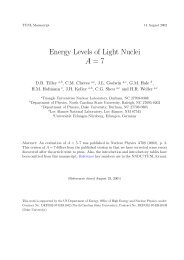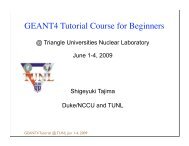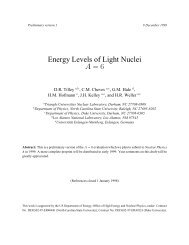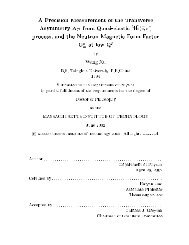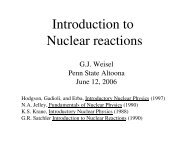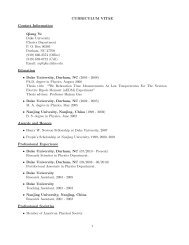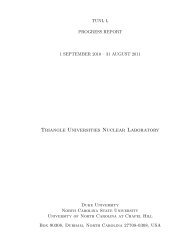Energy Levels of Light Nuclei A = 14 - Triangle Universities Nuclear ...
Energy Levels of Light Nuclei A = 14 - Triangle Universities Nuclear ...
Energy Levels of Light Nuclei A = 14 - Triangle Universities Nuclear ...
Create successful ePaper yourself
Turn your PDF publications into a flip-book with our unique Google optimized e-Paper software.
a See references in Tables <strong>14</strong>.16 in (70AJ04), <strong>14</strong>.20 in (76AJ04) and <strong>14</strong>.16 in<br />
(81AJ01).<br />
b See (86AD01).<br />
c See (81BI17): E x = 9172.5 ± 0.3 keV from γ-ray measurements. See also Table<br />
<strong>14</strong>.10, Γ 0 /Γ =(79± 4)%; Γ 0 (from reaction 41 and Table <strong>14</strong>.19)= 7.2 ± 0.4 eV;<br />
Γ c:m: from 13 C(p, p).<br />
d Reduced width for proton emission is <strong>of</strong> the order <strong>of</strong> 1% <strong>of</strong> the Wigner limit. For<br />
recent work on the E p =3.11 MeV resonance see (90WIZV; prelim.).<br />
e (86ZI08); Γ 0 =(11.0 ± 1.7) × 10 ,3 eV: see Table <strong>14</strong>.11. See also (85PR03).<br />
f Weak resonance.<br />
g In the γ 3:09 channel the peak occurs 55 keV higher: interference effects may be<br />
present.<br />
h Part <strong>of</strong> the giant dipole resonance.<br />
i Some broad structures appear in the γ 0 , γ 3:68 and γ 3:85 yields. See also reaction<br />
26 and reaction 25 in (86AJ01).<br />
j See also (86WA13) and Table <strong>14</strong>.<strong>14</strong>.<br />
k Γ =1.2 ± 0.4 keV;Γ p =0.5% <strong>of</strong> single-particle unit. J based on angular<br />
distribution <strong>of</strong> γ 0 . For nature <strong>of</strong> γ-decay see Table <strong>14</strong>.11.<br />
l (2J +1)Γ =(18.5 ± 4.2)Γ/Γ p eV; if J =1,Γ ≥ 6eV.<br />
m (2J +1)Γ 0 =2.3 Γ/Γ p eV,ifΓ=38eVisassumed.<br />
n (2J +1)Γ 0 ≥ 200 eV: thus the transition is dipole and T = 1. The resonance is<br />
asymmetric and it is suggested that two states are involved, one with J =1 , at<br />
E x =12.7 MeV and the other one with 2 , at E x =13.3 MeV.<br />
o (85PR03).<br />
p (90SP02).<br />
23. 12 C( 12 C. 10 B) <strong>14</strong> N Q m = −<strong>14</strong>.9<strong>14</strong>4<br />
This reaction has been studied at E( 12 C) = 1<strong>14</strong> MeV: the spectrum is dominated by <strong>14</strong> N*(8.96)<br />
[J π =5 + ] but there is substantial population also <strong>of</strong> <strong>14</strong> N*(5.83) [3 − ] and <strong>of</strong> a state at E x =11.2<br />
MeV. Angular distributions are reported at E( 12 C) = 49.0 to 93.8 MeV: see (81AJ01, 86AJ01).<br />
24. 12 C( 13 C, 11 B) <strong>14</strong> N Q m = −8.4066<br />
At E( 13 C) = 390 MeV angular distributions have been studied to <strong>14</strong> N*(0, 2.31, 5.8[u]) and to<br />
unresolved structures and continua. The spectra are dominated by the group to <strong>14</strong> N*(5.8) (87AD07,<br />
88VO08). See also (89VO1D).<br />
25. (a) 13 C(p,γ) <strong>14</strong> N Q m =7.55063<br />
(b) 13 C(p, p ′ γ) 13 C E b =7.55063<br />
51


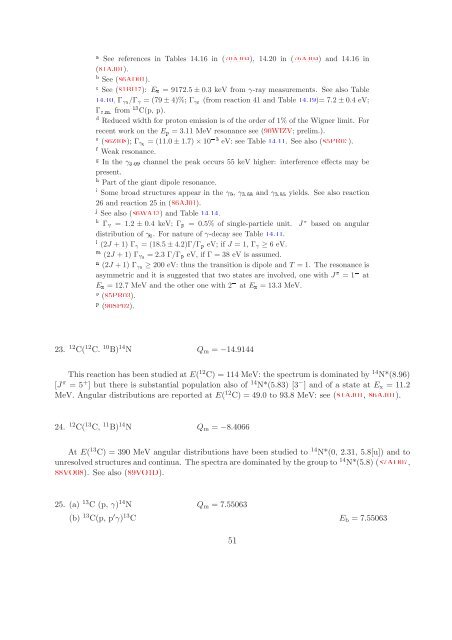
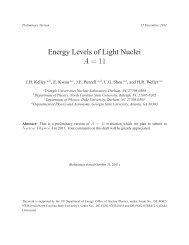

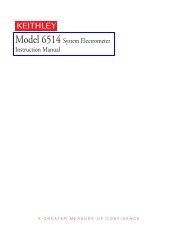
![TUNLXXXIV.tex typeset [1] - Triangle Universities Nuclear Laboratory](https://img.yumpu.com/47618358/1/190x245/tunlxxxivtex-typeset-1-triangle-universities-nuclear-laboratory.jpg?quality=85)
